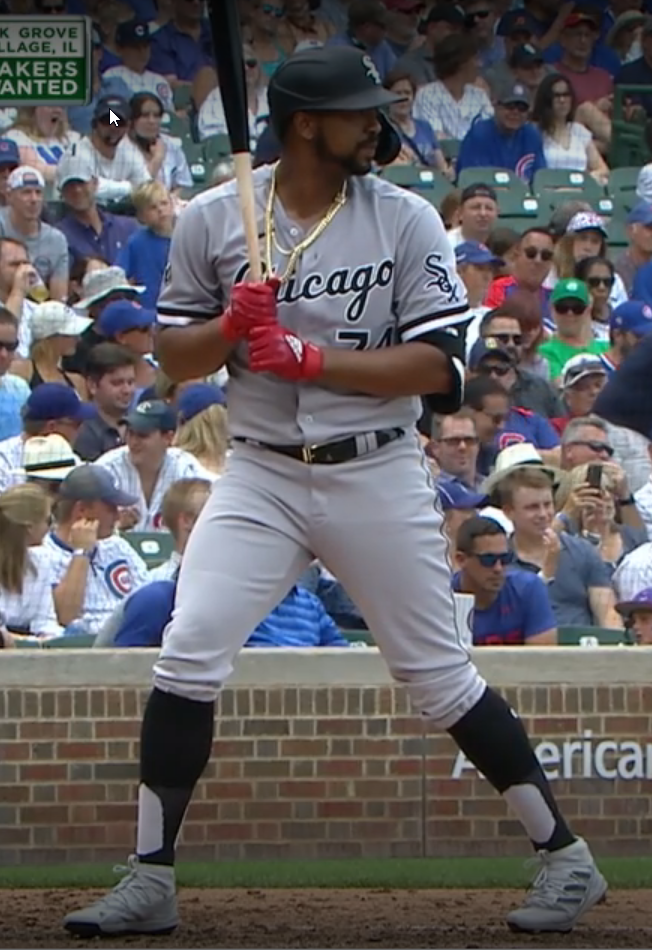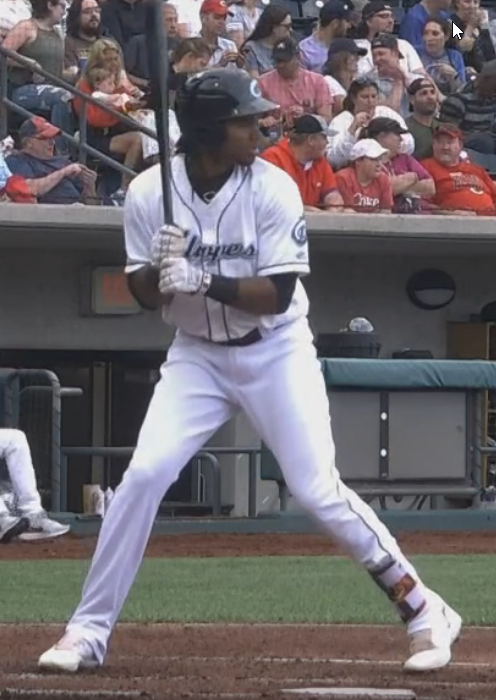beef noun
\ bēf \
- Muscle, particularly those used to hit baseballs over a fence.
- The dream a player becomes a major league long ball artist.
- A Body Mass Index over 25.
- Pitchers named Lance or Bartolo.
- A conflict.
Beef speculation is a tricky game, but I recommend one allowance of speculative beef per team. Franmil Reyes, Rhys Hoskins, and Hunter Renfroe are my better cheap success stories of recent years. There have been far more “misses” but it’s been an overall worthwhile endeavor. By nature, such a prospect has issues, otherwise, they’d likely be premium prospects. A player whose calling card is power production very much has a place in fantasy.
23-year-old Oscar Gonzalez is listed at 6’4″, 240 pounds and that’s not blown out of proportion. He’s a physical specimen. We’re talking lean-muscled beef here, not a Vogelbachwerst. Once upon a time, I took a blind J2 swing at him, but somewhere in low-A, he fell out of my favor, not hitting for the kind of power I had hoped.
2021 Gonzalez has had my attention all season, at least from a stat sheet sense and impressing on a handful of look-ins. Somewhere in the middle of his .330/.367/.601, 13 HR, 18.1 K% 49 game double-A run, I lacked my portion of beef in a 30-teamer and re-kindled this affair, albeit in a somewhat blind fashion again. (I can get a little jumpy when my cast-offs start throwing up some numbers.) A triple-A promotion brought some numbers too; .278/.310/.454, 4 HR, 28.3 K% during your first taste doesn’t look too bad, and power numbers have ticked up of late.
It came time to make a decision, and I found time to delve in, binge-watching all the triple-A plate appearances, taking in how this version of Gonzalez was putting up numbers, and if the impression he left me years ago had changed. Here’s a link to my notes if curiosity strikes you.
Gonzalez looks a lot like fellow Dominican Eloy Jiménez, in both stature and unique setup in the box:


The camera catches Gonzalez a bit slouched there, but he stands more upright. Jiménez’s stance is more open, but they both point their feet back toward the catcher, keeping their front foot high on its toes during delivery. This technique helps keep their weight back during load and more balance in swing, theoretically. Here’s a look at Jiménez putting a nice swing on the ball. You’ll see his leg lift is typically more pronounced than Gonzalez’s.

But this is as far as my Jiménez comparison goes, as you’ll see, they are different hitters with very different swings. Jiménez is well synchronized with the bat “flowing” through the zone, whereas Gonzalez will look more labored, with the bat often lagging behind the body.
Gonzalez had a nice single here during his second triple-A game, but notice the flight path of the ball. The ball spins similar to a golfer’s slice. It is not super pronounced here, but it will be a theme. This is actually one of the better swings we will see in terms of synchronization of bat and body:

(PA #6 vs James Marvel 7/7)
Here, some swing and miss on a breaking ball out of the zone… another theme:

(PA #21 vs Ian Hamilton 7/14)
It may sound goofy, but Gonzalez has quick hands, but a long swing. I think you can start to see that here, coupled with some more breaking ball trouble:

(PA #23 vs Andrew Vasquez 7/14)
If you have a long swing, it behooves you to try and hit to all fields… but it just happens too, as the ball gets deep on you. I think Gonzalez understands this. You will catch plenty of batted balls going opposite field, sometimes by design, sometimes because he just isn’t getting the bat head around quick enough. You see him trying too. This was a nice little recovery after taking a giant swinging hack at his pitch to hit, ending in some mid-pitch adjustment and just enough wood for a nice two-out RBI bloop single:

(PA #25 vs Nick Vincent 7/14)
At this point, another theme is forming:

(PA #32 vs Jovani Moran 7/17)
Through his first two triple-A series (weeks)/41 plate appearances, he’s sitting .270 with two runs-batted-in, one extra-base hit, which was a pulled double off a Matt Shoemaker up-and-in “heater”, nine strikeouts, and not a lot of hard contact. Gonzalez is strictly a corner outfielder with ok in-line speed and an arm that flashes cannon. Splitting time between right and left fields, he’s been hitting sixth through eighth in the order, with some five-hole run in August.
The book is opened on him at our point in the dive and it reads something like struggles against breaking balls and the long swing can be beat up and in. The following at-bat, he does well to get around on the fastball, but it’s the standard breaking balls, preferably down and away, and get the fastball past him up-and-in routine:

(PA #42 vs Jake Jewell 7/20)
Gonzalez gets on a little run. Here he takes a down and away fastball to the right-field wall. You get a sense of his strength and the bat speed he can generate, as he’s off-balanced with the back foot sliding out on him. Is this a swing grooved to go opposite field or just his standard swing which lets the ball get deep on him?

(PA #43 vs Cory Abbott 7/21)
Then he pulls the hands through for his first triple-A home run:

(vs Cory Abbott 7/21)
The next day, an RBI double after a plethora of breaking balls, some of which were good pitches to hit he missed. The off-balanced-stay-alive-swooping swing ends in a good result:

(PA #47 vs Joe Biagini 7/22)
The next 17 plate appearances are a 1 for 15 with a rare walk (5.5% in double-A, 3.5% in triple-A), a hit-by-pitch, four strikeouts, plenty of ugly swings, and no batted balls leaving the infield, including his single which got halfway to the pitcher’s mound. Here’s a typical at-bat during this run…actually the exit velocity was on the upper end:

(PS #62 vs Micheal Ruckers 7/25)
Then he goes on a little run again, starting with this scorching, two-strike RBI single stemming from a beautiful cut (eye roll):

(PA #63 vs Dakota Mekkes 7/25)
Hop on a bus to Nashville…PA #64 he gets an 0-2 curveball down and away putting a similar ugly swing on as above, but somehow pulled it past the shortstop for a single. Then he runs into this down-and-in breaking ball for home run #2:

(PA # 65 vs Dylan File 7/27)
Sitting two for three on the day with the solo big fly, Gonzalez comes up in a bog spot, top of the 8th RISP, and the swing-hard-in-case-you-hit-it comes out 3-2:

(PA #67 vs Luke Barker 7/27)
The next night, Gonzalez got a slew of hanging Josh Lindblom breaking balls and a grooved fastball. But he didn’t do anything with them, going o-4 with a strikeout and weak contact. Missing good pitches to hit is happening often. The rest of the Nashville series includes two ground ball singles, more big hacks, three strikeouts, but everything is weak contact, mostly on the ground, rolling over on breaking balls…except home run #3:

(PA #83 vs Quintin Torres-Costa 7/31 game)
He had a chance to come up the big series finale, but it was ugly:

(PA #85 vs Dylan File 8/1)
Gonzalez has not been hitting very many line drives, but PA #87 is a scorching line drive off the right-field wall for a hard-hit single via our old friend Eddie Butler (who’s recently changed up his look and I DO NOT dig it). The pitch was a 2-0 down-and-in fastball he intended to pull, but his late, golf-slice-swing where the bat-head travels more toward the body through impact, produced some ball flight similar to one of my tee shots. You can see some of this during his second at-bat as well:

(PA #88 vs Eddie Butler 8/3)
I mention this “slice” stuff because there are a lot of goofy ball paths coming off his bat. He is not a hitter who strikes through the ball squarely often. He is really strong though, capable of getting enough end-of-the-bat contact and the like resulting in more than his fair share of odd-duck singles and things. It’s really the only reason his batting average is what it is. This isn’t a guy lining out often, nor a guy hitting many doubles in the gap…I think there was one. At this point of my dive, it’s not really beefy at all. And even during an at-bat ending in an opposite-field home run (#4), there’s plenty of ugly to be seen; huge wild hacks, a giant flinch on a hanging breaking ball fit for a good hitter’s cookie, but the strength wins the day:

(PA #92 vs Dylan Coleman 8/3)
I don’t know why Dylan Coleman didn’t just go with the breaking ball after seeing that flinch, but he learned his lesson the next couple of times their paths crossed, making Gonzalez look even sillier:

(PA #104 vs Dylan Coleman 8/6)

(PA #110 vs Dylan Coleman 8/8)
Through 8/9, and 114 triple-A plate appearances the .278 batting average and 28.3 K% feel like fiction. No way I’d think these numbers were there watching all these at-bats. Gonzalez’s 2021, at least so far, is a great example of how numbers can be fool’s gold. Yet, for a hitter getting his first taste of triple-A, this is probably an unfair sample size, and my last binge-watch was such a fun feast, worried I may be overly pessimistic, I hopped around his double-A games, watching the stretches of hits. There were definitely more of these kinds of results:

(vs Jonathan Hennigan 5/21)
But the hits that weren’t home runs were still a lot like these, still lacking the line drives:

We are after bottom line numbers as dynasty players, so I want to say it’s to his credit he’s putting up the numbers he is. There have been plenty of unconventional players, swings, and methods capable of results good enough to land a big-league role. Gonzalez has made things work enough to get himself pretty far along. He could run into enough home runs and toss in enough odd singles to hang around, but I can’t help but think of Yermín Mercedes and how he forgot about the most important part of being a good hitter: punishing mistakes.
Gonzalez’ reputation as a young pro was as a swing at everything guy. The strikeouts didn’t, and aren’t, coming at huge rates, but perhaps ditching plate coverage for more of a focus on doing damage when he should would be more productive? Like Mercedes’ paranoia over the fringes of the zone, while doing nothing with pitches middle-middle, Gonzalez needs to do more with them too. I saw plenty of missed opportunities on fastballs fit for driving, but the breaking ball down and away felt like it worried him too much. Not to mention the gazillion hanging breaking balls he missed, but that may be a whole other story. This would of course require some pitch recognition skills I’m not sure are there.
At the end of the day, this iteration of Gonzalez feels about as beefy as my wife’s whatever’s-in-the-pot with garbanzo beans. OK, that’s not fair. There’s beef here in regards to definition #1, but I’m not buying this skill set produces many major league bombs. At 23, in triple-A, as his organization sits at the major-league level, the show could happen, but I’m not putting my money on this turning into something I’m losing sleep over if I miss out.
So I’m still in the market for a serving of beef in a deep 30-teamer. I’ve got my speculative portion of Robert Perez elsewhere. Hmm…got any ideas?


That was a fun read. Thanks
Thank you!